Rajasthan Board RBSE Class 12 Biology Chapter 37 Mutations
RBSE Class 12 Biology Chapter 37 Multiple Choice Questions
Question 1.
What is a Genome?
(a) Sum total of a haploid set of chromosome & extra chromosomal material of the cell
(b) Total No. of a chromosome is an organism
(c) diploid sets of chromosomes
(d) number of chromosomes found in the zygote
Answer:
(a) Sum total of a haploid set of chromosome & extra chromosomal material of the cell
![]()
Question 2.
How many numbers of nucleotides pairs found in human?
(a) 3 lac
(b) 30 lac
(c) 3 crores
(d) 3 Billion
Answer:
(d) 3 Billion
Question 3.
What is the basis of DNA fingerprinting?
(a) Self copy of DNA
(b) Fingerprint of DNA
(c) DNA fingerprints of two individual are not the same
(d) none of the above
Answer:
(c) DNA fingerprints of two individual are not the same
Question 4.
Dolly was produced by the help of which technique:
(a) From normal hybridization
(b) From normal sexual reproduction
(c) From cloning
(d) From Tissue Culture
Answer:
(c) From cloning
![]()
Question 5.
What is a Mutation?
(a) Change in the genetic material of DNA
(b) Permanent and Hereditary change in the DNA
(c) Change in the cytoplasm of the cell
(d) any kind of variations
Answer:
(b) Permanent and Hereditary change in the DNA
Question 6.
If adenine is replaced from guanine than mutation is –
(a) Frameshift mutation
(b) Transcription
(c) Transition
(d) Transversion
Answer:
(c) Transition
Question 7.
Genetic code includes –
(a) 3 nucleotide bases, 64 codons
(b) 3 nucleotide bases, 18 codons
(c) 2 bases, 32 codons
(d) 2 bases, 64 codons
Answer:
(a) 3 nucleotide bases, 64 codons
![]()
Question 8.
Polyploidy can be produced by –
(a) Colchicines
(b) X rays
(c) Gamma Rays
(d) None of Above
Answer:
(a) Colchicines
RBSE Class 12 Biology Chapter 37 Very Short Answer Type Questions
Question 1.
Human Genome Project was started by which international Agencies.
Answer:
National Institute of Health and Department of Energy, America.
Question 2.
What are VNTRs?
Answer:
A variable number of Tandem Repeat are small segments of nucleotides which are repetitive.
Question 3.
The stage through which change in a group of chromosomes numbers occurs is called?
Answer:
Polyploidy.
![]()
Question 4.
What is Non-disjunction?
Answer:
Failure of a pair of homologous chromosomes to separate in meiosis – I, failure of sister chromatids to separate during meiosis – II is called non-disjunction.
Question 5.
What are mutagens?
Answer:
The factors which produce mutations are called mutagens.
Question 6.
Define Probe.
Answer:
The probe is a fragment of DNA or RNA of variable length which can be radioactively or fluorescently labelled.
![]()
Question 7.
What is the Honolulu Technique? Who developed this technique and where.
Answer:
It was developed by Teruhiko Wakayama and Ryuzo Vanagimachi at University of Hawaii (1998). It is used to produce an animal clone.
RBSE Class 12 Biology Chapter 37 Short Answer Type Questions
Question 1.
Define Gene Mutation.
Answer:
Some time mismatch combination of nitrogenous bases occurs in daughter DNA. If this change occurs at gene level it is known as Gene Mutation.
Question 2.
What is duplication?
Answer:
Duplication:
Sometimes, some genes are present more than once in a chromosome i.e. one, segment repeats twice in a chromosome. It is called duplication.
![]()
Question 3.
Define point mutation.
Answer:
It occurs at a particular locus of the chromosomes so it is also known as a Point mutation.
Question 4.
Define genome.
Answer:
Genome:
- It is a scientific project which was aimed to study the complete sequence of the human genome. Genes are the key which decides how we appear and work. Moreover, the genes indicate our history and future.
- The DNA sequence is different in two individuals at a certain location, this promotes the scientists to completely sequence a human genome.
- The haploid set of chromosomes in a cell is called a Genome.
Question 5.
What is Euploidy?
Answer:
Euploidy or Polyploidy:
The total set of a number of chromosomes in cell or organism is called monoploidy. The gaining of one or more complete sets of chromosomes is called euploidy. This can be of two types –
- Autopolyploidy
- Allopolyploidy
![]()
Question 6.
What is a silent mutation?
Answer:
Silent Mutation:
Silent mutations are base substitutions that result in no change of the amino acid or amino acid functionality when the altered messenger RNA (mRNA) is translated. For example, if the codon AAA is altered to become AAG, the same amino acid – lysine – will be incorporated into the peptide chain.
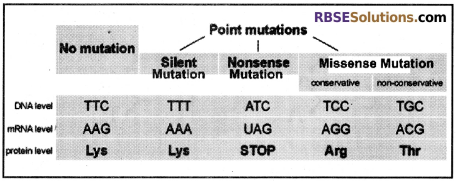
Question 7.
What is gene cloning?
Answer:
Gene Cloning:
- The production of a large population of a DNA fragment in pure form is called as gene cloning.
- It involves the formation of recombinant DNA and its introduction into the mother bacterial cell.
- The recombinant DNA is formed by combining DNAs from two different organisms.
- This process is called genetic engineering. A DNA fragment of one organism (called as Passenger DNA) is transferred into another organism by combining it with another DNA(called as Vehicle DNA).
- Normally plasmid or bacteriophage DNA is used as Vehicle DNA. Both the passenger and vehicle DNA are cleaved by using restriction endonuclease enzyme and they are mixed under suitable conditions.
- Their complementary sticky ends pair and their ends are sealed by ligase enzyme. The resulting DNA is called recombinant DNA.
- The recombinant DNA is added to the culture containing growing host bacteria.
- These bacteria take the recombinant DNA along with the nutrients.
- This DNA replicates when the bacteria divide and produce a large clone of recombinant DNA.
Question 8.
Define Wobble Hypothesis.
Answer:
The genetic codes are ambiguity in nature. It means a particular amino acid can be coded by more than one codons. It was explained by Crick who gives Wobble hypothesis. According to this theory, if the amino acid is coded by more than one code than initial two nucleotides of the codon are same only 3rd nitrogenous base are different.
RBSE Class 12 Biology Chapter 37 Essay Type Questions
Question 1.
What is the mutation? Write the features of mutation.
Answer:
Mutation:
- The sudden changes in the hereditary material i.e. Chromosomes are termed as mutations.
- Hugo De Vries (1901) propounded “theory of mutation”.
- It is based on the results of experiments on a plant, the evening primrose.
- De Vries explained that mutations are sudden changes and are the sole agent for evolution.
- Mutations are always irreversible.
Features of Mutation:
- Mutations occur from time to time among the individuals of a naturally breeding species.
- The mutant organisms are markedly different from their parents.
- Mutations are large, sudden & are heritable.
- Mutations lead to the formation of new species.
- Mutations are both harmful & beneficial.
- The animals with harmful mutations are destroyed by natural selection and the beneficial mutations get established in the animals.
![]()
Question 2.
Describe the structural changes in chromosomal mutation.
Answer:
Chromosomal mutation or Chromosomal aberration or Numerical changes in
chromosomes:
Any change in gene arrangement or insertion of a gene or deletion of a gene then these changes are known as Chromosomal Mutation. They are of two types:
- Change in the number of chromosomes
- Change in the structure of chromosomes
1. Change in the number of chromosomes.
It is of two types:
(1) Euploidy or Polyploidy:
- The total set of a number of chromosomes in cell or organism is called monoploidy. The gaining of one or more complete sets of chromosomes is called euploidy.
This can be of two types –
(a) Autopolyploidy:
- It is a type of euploidy, where the additional set of chromosomes is derived from a parent or identical parental species.
- For example Triploid, Tetraploid, Pentaploid etc. Colchicine which is isolated from the corn of Colchicum autumnale has an ability to destroy spindle fibres during cell division so that the chromosomes do not move to the respective poles and ultimately chromosome number gets double.
(b) Allopolyploidy:
- In this type, more than two haploid sets of chromosomes that are dissimilar and derived from different species are added.
- Example: Raphnobraccia (2n = 36). Russian scientist GD. Carpichako(1927) make a cross between Raphanus sativus (Radish) and Brassica oleracea (Cauliflower);. It is sterile. Triticale is a cross product of Triticum (wheat) and Secale (Rai) is also used as man-made cereal “Triticale” and is commercially exploded all over.
(2) Aneuploidy:
- Aneuploidy is the addition or loss of one or more chromosomes to the complete diploid chromosome complement of an organism. It is caused by nondisjunction of the chromosome during segregation of chromosomes.
It is of two types –
(a) Hypoploidy:
- Hypoploidy is the loss of one or more chromosomes from the diploid genome. If there is a loss of one chromosome (2n – 1), it is called monosomy and if the loss of pair of chromosome (2n – 2), it is called Nullisomy.
(b) Hyperploidy:
- Addition of one or more chromosome it is called Hyperploidy.
- Excess of one chromosome is called trisomy.
- Example: Down’s syndrome or 21st trisomy or Mongolism or Mongoloid Idiocy. (2n + 1)
- Excess of two chromosomes is called as tetrasomy (2n + 2).
2. Change in the structure of chromosomes:
- These mutations result in structural changes in the chromosome. Hence, the original structure of the gene is changed.
- They involve changes either in the total number of genes or gene loci in a chromosome or their rearrangement.
They are of 4 types –
(a) Deletion:
- It is the simplest kind of chromosomal aberration.
- The deletion is loss of chromosomal segment.
- Terminal deletion refers to the loss of a segment from one or the other end of the chromosome.
- Intercalary of Interstitial deletion involves an intercalary segment of the chromosome with the reunion of the terminal segment.
(b) Translocation:
- It is a type of chromosomal aberration.
- A chromosomal segment goes to another chromosome (Unilateral) or normally, exchange of chromosomal segment (genes) between two non-homologous chromosomes (Bilateral).
- Sometimes there is a change in the expression of the gene due to Position effect.
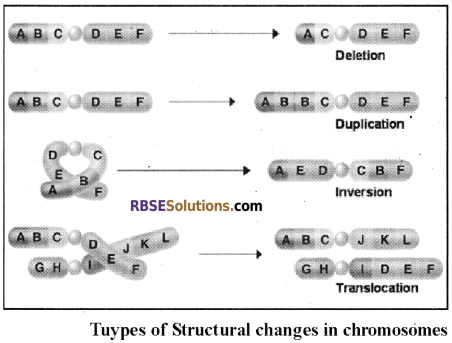
(c) Inversion:
- Some times the number of genes in a chromosome does not change but the sequence of genes is altered by the rotation of the chromosomal segment within the chromosomes by 180°. Due to these change, genotypes remains unchanged but phenotypic characters change.
(d) Duplication:
- Sometimes, some genes are present more than once in a chromosome i.e. one, segment repeats twice in a chromosome. It is called duplication.
![]()
Question 3.
Describe the Human Genome Project.
Answer:
Human Genome Project:
- The human genome project (HGP) is a project to map and sequence the 3 billion nucleotides contained in the human genome and to identify all the genes present in it.
- It is under the control of an international body, the Human Genome Organization (HUGO). This project was started in 1988 by the US Department of Energy (DOE). The DOE and National Institute of Health (NIH) hand in hand started this project in 1990.
- 250 laboratories from 8 countries were involved in this project James D. Watson was the leader of the project and it was started under the leadership of Francis Collins. This is also called Mega Project & it was completed in 2003.
Aims of the Human Genome Project:
- To identify one lakh genes in human DNA.
- To determine the base sequence of 3 billion chemical base pairs that make up human DNA.
- To store this information in the database.
- To improve tools for data analysis.
- To address the ethical, legal and social issues that may arise from the project.
- To determine the sequence of several modal organisms like E. coli, yeast, Drosophila, rat (Mus musculus)
The technique used in the Human Genome Project:
There are two types of approaches for analyzing the genome.
- Identify all the genes that are expressed as RNA – Expressed sequence tags or ESTs.
- Sequencing the whole genome (both coding and non-coding regions) and later assigning the different regions with functions – Sequence annotation.
The second methodology was used in the HGP which involves the following steps:
- The whole DNA of the cell is isolated and broken randomly into fragments.
- They are inserted into specialised vectors like BAC (bacterial artificial chromosomes) and YAC (yeast artificial chromosome).
- The fragments are cloned in suitable hosts like bacteria and yeast. PCR (polymerase chain reaction) can also be used for cloning or making copies of DNA fragments.
- The fragments are sequenced as annotated DNA sequences (an offshoot of the methodology developed by double Nobel laureate, Frederick Sanger), Sanger used Di-deoxy Chain Termination method through advanced DNA sequences.
- The sequences were then arranged on the basis of some overlapping regions. It necessitated the generation of overlapping fragments for sequencing.
- For physical and genetic mapping of sequence recognition sites of restriction endonuclease are used which are located on microsatellite of the chromosomes. Sequencing of the overlapping end is done through a special sequence program through the computer.
Salient Features of Human Genome:
- The human genome has 3.1657 Billions of nucleotide base pairs.
- According to a presumption of the human gene from 80,000 – 140000 but HGP revealed the Number of genes has 30,000.
- The average gene size is 3000 base pairs. Dystrophin is the biggest gene, contains 2.4 crores base pairs.
- Human Genome project revealed Single Nucleotide polymorphism (SNP). At 104 million places this SNP is found. It helps in identifying sequence for disease on the chromosome.
- The function of 50% of genes has been identified.
- Less than 2% of genes are involved in protein synthesis.
- Chromosome Number 1 has the highest gene number which is 2968 genes and the lowest number of genes are present in the Y chromosome which only 231 genes.
- 99.9% of the nucleotide bases are exactly similar in all human beings.
- Only 0.1% of the human genome with some 3.2 million nucleotides represents the variability observed in human beings.
- Repeated or repetitive sequences make up a large portion of the human genome. There are some 30,000 minisatellite loci, each having 11 – 60 bp repeated randomly up to a thousand times. These are about 2,00,000 microsatellites, each with up to 10 basic pair repeated 10 – 100 times.
- Repetitive sequences are nucleotide sequences that are repeated many times, sometimes hundred to thousand times. They do not have direct coding function but provide information as to chromosome structure, dynamics and evolution.
![]()
Question 4.
Explain in detail about DNA fingerprinting technique and write about its applications.
Answer:
DNA Fingerprinting:
- Human is identified by their names and their characteristic. No two organisms have similar characteristics. (except identical twins).
- There are certain characteristics such as skin colour, hair colour, the colour of pupil of eye, height, voice, a pattern of walking, sitting, way of talking, way of living through which we can differentiate or identify two individuals.
- Every individual differs in fingerprints. There is a difference in imprints and pristine we observe is called fingerprint.
- This is actually an official way of identification of an individual. It was developed by Francis-Galton, which is still in use.
- Alec Jeffreys & colleagues (1985) were investigating a DNA fragment from the gene for a human blood protein, globin.
- They discovered that this fragment contained a sequence of bases repeated several times.
- This repeated DNA is called as minisatellite. Further, the same minisatellite sequence was found in other places in the human genome repeated several times.
- More interestingly, the individuals differ in the pattern of repeats of the base sequence & they differ enough that two individuals have only a remote chance of having exactly the same pattern.
- That means that these patterns are like fingerprints & are called by Jeffreys as DNA fingerprints.
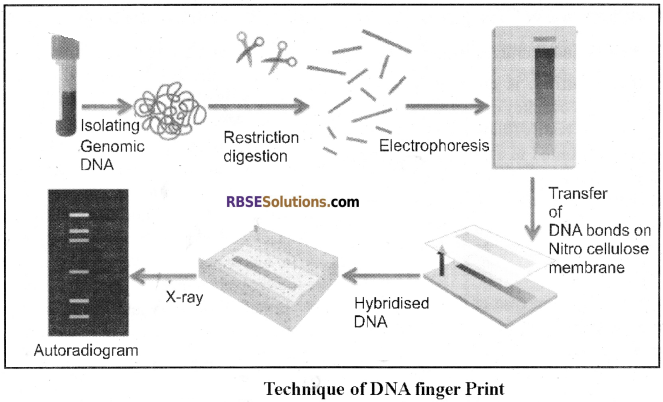
Principle:
- Several small nucleotides are found repetitively in DNA. They are called VNTRs (Variable Number of Tandem Repeats).
- The length to VNTR of two persons may be of the same length but the sequence will be different.
- In every child half of the VNTRs come from mother and other half comes from father.
DNA fingerprinting Technique:
- DNA is isolated from the source material like a drop of blood, saliva, semen, teeth etc. by the help of high-speed Refrigerated centrifuge.
- If DNA is less in the amount it should be amplified using Polymerase Chain Reaction (PCR).
- DNA is cut into fragments using restriction endonuclease enzyme for Restriction Fragment Length Polymorphism (RFLP).
- These fragments are poured into separate wells of an electrophoresis gel and electrophoresed. These fragments are stained with fluorescent dyes like Ethidium Bromide and observed under UV light.
- Alkaline solutions changed this double-strand DNA into single-strand DNA. This process is known as Denaturation.
- The separated DNA fragments are transferred to a nitrocellulose membrane by placing it over the gel. This process is called Southern Blotting.
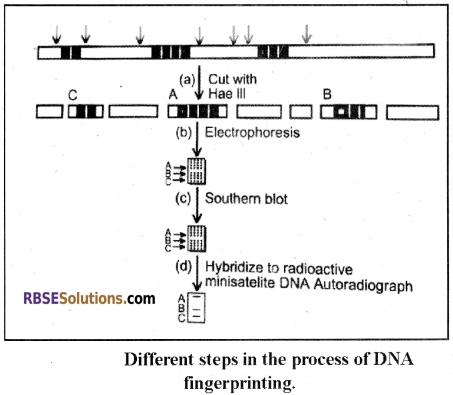
Application of DNA Fingerprinting:
- In Criminal cases and Family affairs:
- DNA fingerprinting is commonly used in forensic cases to undercover key evidence for criminal trials. In crime scenes, bodily fluids such as blood are taken as samples and tested in a lab to help identify the DNA of individuals who might have contributed or been the victim of the crime. For this technique biological wastes such as blood may be dried, semen, hair, tooth, a piece of bone, anybody tissues etc. is obtained at the site of crime.
- This technique is also used in case of disputed parents where DNA of probable parents are tested against child DNA and help in the identification of actual parents.
- This technique is also helpful in Murder, rape, crime, property nomination, divorce cases. Where the identification of parent is very important. Every individual has received DNA from its parents and can be identified by the help of VNTRs.
- Medical Field:
Several hereditary diseases can be detected at the early stage of pregnancy. It can be managed at a certain level through DNA fingerprinting. - It is used to assess the pattern of migration of ancient populations.
- It is also employed in the genetic analysis of various strains of agricultural crops and animals.
- It is also employed to understand evolution.
![]()
Question 5.
What do you mean by cloning? Explain how first animal clone was produced?
Answer:
Cloning:
- A group of cells or organisms which originate from one parent cell/organism and which are similar physically and genetically to the parent are called a clone. The process of formation of a clone is called cloning. (G. Klon > cutting used for propagation).
- In simple organisms, the cloning is found in a natural way. But it is lacking in higher animals.
Identical Twins are also like clones as they are formed by the first division of a single zygote so these two divided cells grow individually and develop into a complete separate embryo. - In plants, tissue culture technique is used to make plants. In tissue culture technique a single cell from the desired plant is cultured in a suitable medium
Process of Cloning of Doly:
- Ian Wilmut and coworkers in (1995) prepared Magon and Morgan clones of sheep by nuclear transplantation from sheep embryo into sheep ovum at Roslin Institute, Scotland. In Feb 1997, Ian Wilmut has produced a clone of an adult lamb named “Dolly”.
- Further, in July 1997, Ian Wilmut and coworkers prepared sheep clones called Polly and Molly.
- These clones were created from a single cell taken from the udder of an adult sheep. The complete procedure is shown below.
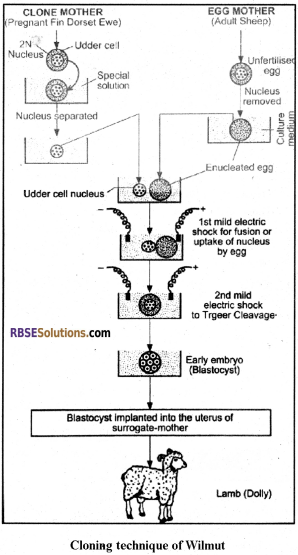
![]()
Question 6.
Explain in detail changes in chromosomal numbers.
Answer:
Change in the number of chromosomes.
It is of two types:
(1) Euploidy or Polyploidy:
- The total set of a number of chromosomes in cell or organism is called monoploidy. The gaining of one or more complete sets of chromosomes is called euploidy.
This can be of two types –
(a) Autopolyploidy:
- It is a type of euploidy, where the additional set of chromosomes is derived from a parent or identical parental species.
- For example Triploid, Tetraploid, Pentaploid etc. Colchicine which is isolated from the corn of Colchicum autumnale has an ability to destroy spindle fibres during cell division so that the chromosomes do not move to the respective poles and ultimately chromosome number gets double.
(b) Allopolyploidy:
- In this type, more than two haploid sets of chromosomes that are dissimilar and derived from different species are added.
- Example: Raphnobraccia (2n = 36). Russian scientist GD. Carpichako(1927) make a cross between Raphanus sativus (Radish) and Brassica oleracea (Cauliflower);. It is sterile. Triticale is a cross product of Triticum (wheat) and Secale (Rai) is also used as man-made cereal “Triticale” and is commercially exploded all over.
(2) Aneuploidy:
- Aneuploidy is the addition or loss of one or more chromosomes to the complete diploid chromosome complement of an organism. It is caused by nondisjunction of the chromosome during segregation of chromosomes.
It is of two types –
(a) Hypoploidy:
- Hypoploidy is the loss of one or more chromosomes from the diploid genome. If there is a loss of one chromosome (2n – 1), it is called monosomy and if the loss of pair of chromosome (2n – 2), it is called Nullisomy.
(b) Hyperploidy:
- Addition of one or more chromosome it is called Hyperploidy.
- Excess of one chromosome is called trisomy.
- Example: Down’s syndrome or 21st trisomy or Mongolism or Mongoloid Idiocy. (2n + 1)
- Excess of two chromosomes is called as tetrasomy (2n + 2).